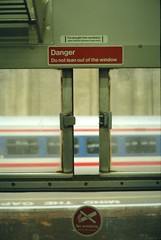
Mark1 carriage window
Originally uploaded by seadipper.
These sliding ventilators came into use in the 1930s. They were an advanced design with an aerofoil to deflect the air flow over the moving train and provide draught-free ventilation if they are opened up to the black marks on the notice above the warning sign.
If the weather is hot and you want a good blow, you open them all the way.
Unlike air conditioning, they do not consume a lot of power, are inexpensive to install and maintain, and do not break down when they are most needed, in the middle of the summer.
They also have the advantage of letting some steady ambient noise into the train which drowns out the annoying sounds of mobile phones, personal stereos and loud conversations, so you can blank it out and concentrate on what you are doing. I suspect they are more hygienic than air conditioning - I have always wondered what life-forms live in the ducting.
Unfortunately, some bright spark though that hopper ventilators (windows that open inwards from the top) were a better idea than these, so after the mid-1970s, they were no longer fitted to new trains and on some of the old trains the sliding ventilators were replaced by hoppers. These do not stay shut or half-open properly, prevent blinds or curtains from being fitted and cannot be opened without causing a hell of a draught.
It was then concluded that air conditioning was essential on new trains apart from those used for short journeys. So most new trains have full air conditioning. This means that carriages are so complex that they cannot be stored without running up the systems regularly, which means they need quite a lot of attention even if they are not in service. This is why trains are overcrowded whilst surplus carriages are likely to be scrapped as it is too expensive to keep vehicles in reserve.
Inga kommentarer:
Skicka en kommentar